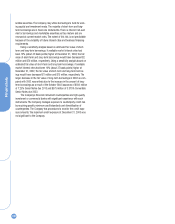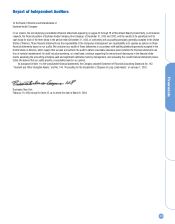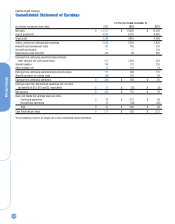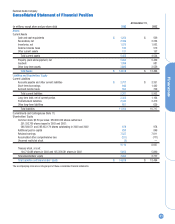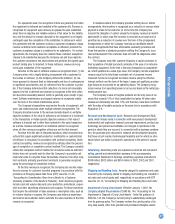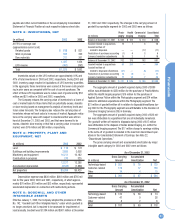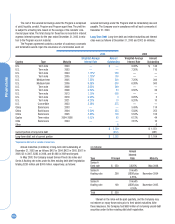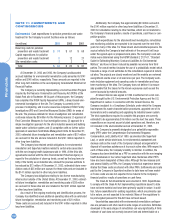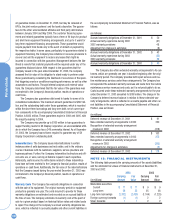Kodak 2003 Annual Report Download - page 48
Download and view the complete annual report
Please find page 48 of the 2003 Kodak annual report below. You can navigate through the pages in the report by either clicking on the pages listed below, or by using the keyword search tool below to find specific information within the annual report.
Financials
48
with indefinite useful lives, for impairment whenever events or changes in
circumstances indicate that the carrying value may not be recoverable.
The Company assesses the recoverability of the carrying value of long-
lived assets by first grouping its long-lived assets with other assets and
liabilities at the lowest level for which identifiable cash flows are largely
independent of the cash flows of other assets and liabilities (the asset
group) and, secondly, by estimating the undiscounted future cash flows
that are directly associated with and that are expected to arise from the
use of and eventual disposition of such asset group. The Company esti-
mates the undiscounted cash flows over the remaining useful life of the
primary asset within the asset group. If the carrying value of the asset
group exceeds the estimated undiscounted cash flows, the Company
records an impairment charge to the extent the carrying value of the long-
lived asset exceeds its fair value. The Company determines fair value
through quoted market prices in active markets or, if quoted market prices
are unavailable, through the performance of internal analyses of discount-
ed cash flows or external appraisals.
In connection with its assessment of recoverability of its long-lived
assets and its ongoing strategic review of the business and its operations,
the Company continually reviews the remaining useful lives of its long-
lived assets. If this review indicates that the remaining useful life of the
long-lived asset has been reduced, the Company adjusts the depreciation
on that asset to facilitate full cost recovery over its revised estimated
remaining useful life.
Derivative Financial Instruments The Company accounts for derivative
financial instruments in accordance with SFAS No. 133, “Accounting for
Derivative Instruments and Hedging Activities.” All derivative instruments
are recognized as either assets or liabilities and are measured at fair
value. Certain derivatives are designated and accounted for as hedges.
The Company does not use derivatives for trading or other speculative
purposes.
The Company has cash flow hedges to manage foreign currency
exchange risk, commodity price risk and interest rate risk related to fore-
casted transactions. The Company also uses foreign currency forward
contracts to offset currency-related changes in foreign currency denomi-
nated assets and liabilities. These foreign currency forward contracts are
not designated as accounting hedges and all changes in fair value are
recognized in earnings in the period of change.
The fair value of foreign currency forward contracts designated as
hedges of forecasted foreign currency denominated intercompany sales is
reported in other current assets and/or current liabilities, and is recorded
in other comprehensive income. When the related inventory is sold to third
parties, the hedge gains or losses as of the date of the intercompany sale
are transferred from other comprehensive income to cost of goods sold.
The fair value of silver forward contracts designated as hedges of
forecasted worldwide silver purchases is reported in other current assets
and/or current liabilities, and is recorded in other comprehensive income.
When the silver-containing products are sold to third parties, the hedge
gains or losses as of the date of the purchase of raw silver are transferred
from other comprehensive income to cost of goods sold.
The fair value of the interest rate swap designated as a hedge of
forecasted floating-rate interest payments is reported in current liabilities,
and is recorded in other comprehensive income. As interest expense is
accrued, an amount equal to the difference between the fixed and float-
ing-rate interest payments is transferred from other comprehensive
income to interest expense.
Environmental Expenditures Environmental expenditures that relate to
current operations are expensed or capitalized, as appropriate.
Expenditures that relate to an existing condition caused by past operations
and that do not provide future benefits are expensed as incurred. Costs
that are capital in nature and that provide future benefits are capitalized.
Liabilities are recorded when environmental assessments are made or the
requirement for remedial efforts is probable, and the costs can be reason-
ably estimated. The timing of accruing for these remediation liabilities is
generally no later than the completion of feasibility studies.
The Company has an ongoing monitoring and identification process
to assess how the activities, with respect to the known exposures, are
progressing against the accrued cost estimates, as well as to identify
other potential remediation sites that are presently unknown.
Income Taxes The Company accounts for income taxes in accordance
with SFAS No. 109, “Accounting for Income Taxes.” The asset and liability
approach underlying SFAS No. 109 requires the recognition of deferred tax
liabilities and assets for the expected future tax consequences of tempo-
rary differences between the carrying amounts and tax basis of the
Company’s assets and liabilities. Management provides valuation
allowances against the net deferred tax asset for amounts that are not
considered more likely than not to be realized.
Earnings Per Share Basic earnings-per-share computations are based
on the weighted-average number of shares of common stock outstanding
during the year. Diluted earnings-per-share calculations reflect the
assumed exercise and conversion of employee stock options that have an
exercise price that is below the average market price of the common
shares for the respective periods.
The reconciliation between the denominator of the basic and diluted
earnings-per-share computations is as follows:
For the Year Ended December 31,
(in millions) 2003 2002 2001
Number of common shares used in
basic earnings per share 286.5 291.5 290.6
Incremental shares from
assumed conversion of options 0.1 0.2 0.4
Number of common shares used in
diluted earnings per share 286.6 291.7 291.0
Options to purchase 35.9 million, 26.8 million and 43.7 million
shares of common stock at weighted-average per share prices of $51.63,
$58.83 and $61.30 for the years ended December 31, 2003, 2002 and
2001, respectively, were outstanding during the years presented but were
not included in the computation of diluted earnings per share because the
effect would be anti-dilutive, meaning that the options’ exercise price was
greater than the average market price of the common shares for the
respective periods. Diluted earnings per share for the year ended
December 31, 2003 also excludes 18.5 million shares related to the
Company’s Convertible Senior Notes, which were issued in October 2003


